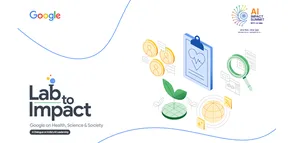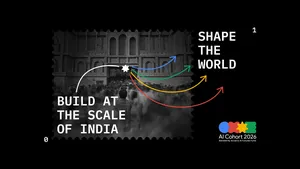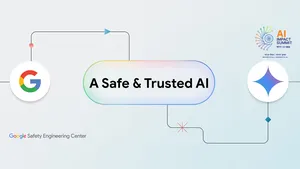New milestones in our journey to build inclusive and helpful AI for India

Throughout the year, we at Google have been releasing new AI models and capabilities, toward helping realize the immense promise of productivity, innovation, and creativity we envisioned with the Gemini era. As we have worked to chart new frontiers in foundational AI – the backbone of many recent launches – researchers across Google have continued contributing to advancing fundamental research, building and deploying AI to help address some of the world’s most pressing challenges.
Beyond our commitment and belief in the potential of AI, we have witnessed the transformative multiplier impact that many organizations have facilitated when using AI to uncover a world of inspiring solutions.
For example, tens of thousands of new and expecting mothers across India are now benefiting from life-saving behavioral changes and heightened awareness, thanks to the non-profit ARMMAN’s health information programs that have been benefited from machine learning models built with pro bono support from Google DeepMind researchers.
Additionally, over 150,000 researchers across India are now accessing a vast knowledge base through the AlphaFold Protein Structure Database. This was built using the AI system developed by Google DeepMind and recognized with a Nobel Prize to Sir Demis Hassabis and Dr John Jumper. India’s researchers are using AlphaFold to help tackle long-standing issues facing humanity – from autoimmune diseases, to cancer, and so much more.
In every instance, AI has served as a powerful catalyst, accelerating progress, unlocking new possibilities, and empowering innovators to tackle complex problems with unprecedented effectiveness.
We’re committed to growing this momentum, and are announcing new capabilities to assist further development of more inclusive and helpful AI.
Empowering agricultural solutions with crop-level insights
Last year, we opened access to the Agricultural Landscape Understanding (ALU) Research API, which leverages AI and remote sensing to provide field-level landscape segmentation that enables the ecosystem to build targeted solutions for the growth and resilience of India’s agricultural sector.
Innovators have used the ALU API for unique solutions. TerraStack, incubated at IIT-Bombay, has built a rural land intelligence system that can support rural lending, land record modernization, and help determine vulnerability of farms to climate risk. The system uses the ALU API to identify farm boundaries and detect potential encroachment and changes in land ownership, which is a crucial factor in the support farmers avail from both the public and private sector.
TerraStack’s rural intelligence system that uses the ALU API for mapping farm boundaries (Image source: TerraStack)

Building on the ALU API, we are now launching the Agricultural Monitoring & Event Detection API (AMED API), which goes one step deeper and provides field-level crop data, specifically helping in monitoring crops and detecting agricultural events at individual fields across India.
The AMED API details the type of crop on a given field, crop season, the field’s size, and also provides historical information about the agricultural activity on it for the last three years. These insights can help significantly strengthen agricultural management on farms, contributing to addressing the specific needs of each crop – including the right soil and water conditions, growing habits, and climatic needs – as well as predicting harvest volume.
And as the data is refreshed nearly every two weeks, partners leveraging the AMED API are able to access continuously updated information that accounts for field-level changes and agricultural events.
Agricultural Monitoring & Event Detection API (AMED API) developed by Google DeepMind and the Google Partnerships Innovation team

TerraStack is already exploring the AMED API for rural lending use cases, showcasing its immediate applicability. We look forward to seeing the many ways India’s developer ecosystem builds solutions that deeply support India’s farmers, helping uplift the country’s agricultural productivity.
Growing the cultural awareness of Generative AI Models
As AI evolves to become more helpful, an important goal for us at Google is to ensure it benefits everyone. For Indian languages, we envision solutions that feel natural and intuitive, and with the appropriate cultural context.
We are therefore excited to collaborate with researchers at IIT-Kharagpur to bring the Amplify Initiative led by Google Research to India, to provide the global language developer ecosystem with free, structured, hyperlocal and high-quality datasets on India’s rich linguistic and cultural diversity. This initiative aims to bridge knowledge gaps within Large Language Models with localized data – including different languages, dialects, and cultural nuances missing from current AI training – enabling models to better serve people in meaningful and relatable ways.
With a community-centric approach, sector experts enter information about important local issues in dedicated privacy-preserving Android and web apps. Regional partners and country research leads with local language and regional expertise translate, evaluate, and validate the queries for local relevance, coherence, fluency, and coverage. Experts, researchers, community partners are trained and aligned to consider responsible practices, potential for bias, and appropriate annotation techniques throughout the development process.
Addressing knowledge gaps through the Amplify Initiative led by Google Research in collaboration with IIT-Kharagpur

The Amplify Initiative was piloted in Sub-Saharan Africa in partnership with Makerere University’s AI Lab in Uganda, and has created an annotated dataset of over 8,000 queries in seven African languages authored collaboratively with 155 experts, addressing a range of topics from chronic disease to misinformation.
As part of the Amplify Initiative in India, our local partner will begin building datasets related to specific issues, including in healthcare and safety, in multiple Indic languages.
This initiative follows our ongoing efforts to strengthen Indian language representation in AI models. Three years ago, we made a significant step, launching Project Vaani in collaboration with Indian Institute of Science and making its Indic speech dataset open and freely available through India’s national language mission, Bhashini, and through the open-source platform, HuggingFace.
While data collection for the second phase of the project is underway, we are pleased to share that this dataset has now started rolling out for public access. To date, a total of nearly 21,500 hours of speech audio and 835 hours of transcribed speech across 86 unique languages, reflecting the contributions of over 112,000 speakers across 120 districts and 22 states, have now been made available to help developers and researchers build applications and solutions relatable for India’s diverse communities.
Our foundational AI models addressing India’s challenges
Beyond our dedicated initiatives to empower the ecosystem, we have worked to make our foundational models more inclusive and helpful. Gemini 2.5 now requires markedly fewer tokens than Gemini 1.5 to process Indic languages, while operating at similar or better efficiency than competing models, translating directly into computational and cost gains for developers building for India.
Example of tokenizer efficiency between Gemini 1.5 Pro and Gemini 2.5 Pro

These benchmark-leading Indic language capabilities are also available in our open source models, and it’s been encouraging to see startups like Sarvam AI leveraging the Gemma family of models to contribute to India’s sovereign AI ambition.
Others across the ecosystem have also been using Gemini for India’s AI-powered ambition: Cropin has leveraged Gemini to build the world’s first real-time agri-intelligence solution, Cropin Sage, which has already helped a leading US-based agri-processing company, among others, to de-risk and future-proof its supply chain against potential climate-related shocks. Manipal Hospital has built an assistive system with Gemini that has reduced the time nurses take to hand over patients between shifts by more than half, enabling them to instead focus more on patient care.
The enthusiastic adoption of our foundational and fundamental research across India has been incredibly encouraging, affirming our sustained investments in AI over the past decade. As we look ahead, we remain deeply committed to this collaborative journey, and charting new frontiers that help build an AI-powered future that is truly more inclusive, innovative, and prosperous for all of India.





